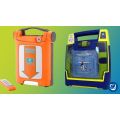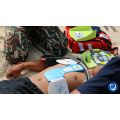Understanding the AHA Curriculum: An In-Depth Guide to the Latest Training Materials
The American Heart Association (AHA) is one of the most recognized and respected organizations in the healthcare industry, dating back to 1924. As a leading provider of life-saving training, the AHA has established a rigorous curriculum that healthcare professionals must master to provide the best patient care. In this guide, we will take a deep dive into the AHA curriculum, including the key components of each certification course and the latest training materials available.
What is the AHA curriculum and why is it important?
The AHA curriculum is a standardized set of guidelines that healthcare professionals must follow to provide safe and effective care for patients. The AHA offers several certification programs, including Basic Life Support (BLS), Advanced Cardiovascular Life Support (ACLS), and Pediatric Advanced Life Support (PALS). These courses cover a range of life-saving skills, including CPR, defibrillation, rescue breathing and medication administration.
What are the key components of the AHA curriculum?
The AHA curriculum is based on the latest scientific research and evidence-based practices. It is designed to provide healthcare professionals with the knowledge and skills they need to provide high-quality patient care. The key components of the AHA curriculum include:
High-quality CPR
The AHA curriculum emphasizes the importance of high-quality CPR. Healthcare professionals are taught how to perform chest compressions and rescue breathing effectively.
Early defibrillation
The AHA curriculum also emphasizes the importance of early defibrillation. Healthcare professionals are taught how to use an automated external defibrillator (AED) to deliver an electric shock to a person in cardiac arrest.
Teamwork
The AHA curriculum also emphasizes the importance of teamwork. Healthcare professionals are taught how to work together effectively to provide care to patients in cardiac arrest and other medical emergencies.
What are the differences between BLS, ACLS, and PALS courses?
The AHA offers different certification courses for healthcare providers: BLS, ACLS, and PALS. Each course has a different focus and level of complexity.
BLS
BLS (Basic Life Support) is a foundation course that teaches healthcare professionals the basic skills needed to respond to cardiac and respiratory emergencies. Basic Life Support (BLS) is the perfect course for pre-hospital and in-hospital/in-facility healthcare professionals and other personnel who need to know how to administer CPR and other basic cardiovascular life support skills.
ACLS
ACLS (Advanced Cardiovascular Life Support) is an advanced course that builds upon the skills learned in BLS and focuses on the management of cardiac arrest and other medical emergencies. ACLS is perfect for healthcare professionals who direct or participate in the management of cardiopulmonary arrest or other cardiovascular emergencies, and for personnel in emergency response.
For pediatric care training, the AHA offers two separate courses that reflect science and education from the American Heart Association Guidelines Update for CPR and Emergency Cardiovascular Care (ECC), PALS and PEARS.
PALS
PALS (Pediatric Advanced Life Support) is similar to ACLS but is specifically designed for healthcare professionals who work with children. Healthcare providers who respond to emergencies in infants and children, as well as personnel in emergency response, emergency medicine, intensive care, and critical care units should be PALS certified.
PEARS
PEARS (Pediatric Emergency Assessment, Recognition, and Stabilization) teaches healthcare providers, such as nurse practitioners, physician assistants, EMTs, and respiratory therapists, assessment, early recognition, prompt communication, and initial intervention in patients with respiratory emergencies, shock, and cardiopulmonary arrest. PEARS is ideal for healthcare providers who might encounter pediatric emergency situations during their work, with the goal of improved outcomes for pediatric patients.
How do I become AHA certified?

To become AHA certified, healthcare professionals must complete the appropriate certification course and pass a skills test. Students can find AHA training centers and course materials on the AHA website or through WorldPoint, a trusted provider of AHA training materials. To register for an AHA course, use the AHA’s Find a Course Near You tool.
How do the AHA training materials help improve patient outcomes?
The AHA training materials are designed to provide healthcare professionals with the knowledge and skills they need to provide high-quality patient care. By mastering the AHA curriculum, healthcare professionals can improve patient outcomes and save lives. WorldPoint offers a range of AHA training materials, including CPR manikins, airway management trainers, and AED trainers, which are essential tools for hands-on training.
What are the best resources for staying up-to-date with the latest AHA guidelines and recommendations?
The AHA is constantly updating its guidelines and recommendations to reflect the latest research and best practices in the industry. Healthcare professionals can stay up-to-date by visiting the AHA website or subscribing to the AHA newsletter. WorldPoint also offers a range of resources to help healthcare professionals stay current, including training videos and educational articles.
Shop AHA curriculum materials & associated training supplies
The AHA curriculum is a critical component of healthcare education and training. By mastering the skills and knowledge taught in these courses, healthcare professionals can provide the best possible care for their patients. WorldPoint is proud to offer a range of AHA training materials to help healthcare professionals achieve their certification goals and improve patient outcomes.
Have any questions about WorldPoint?

Chat with us on our website, www.worldpoint.com, send us an email at customerservice@worldpoint.com, or give us a call at 888-322-8350. We look forward to answering all your questions!
We are WorldPoint. And we are at the heart of your training.















